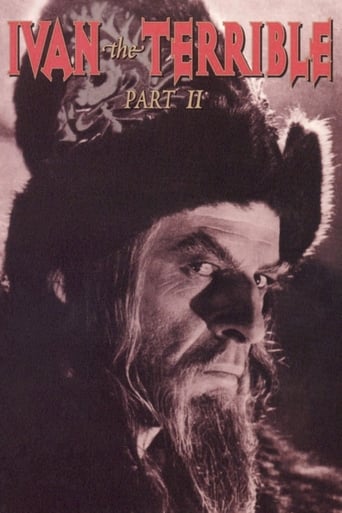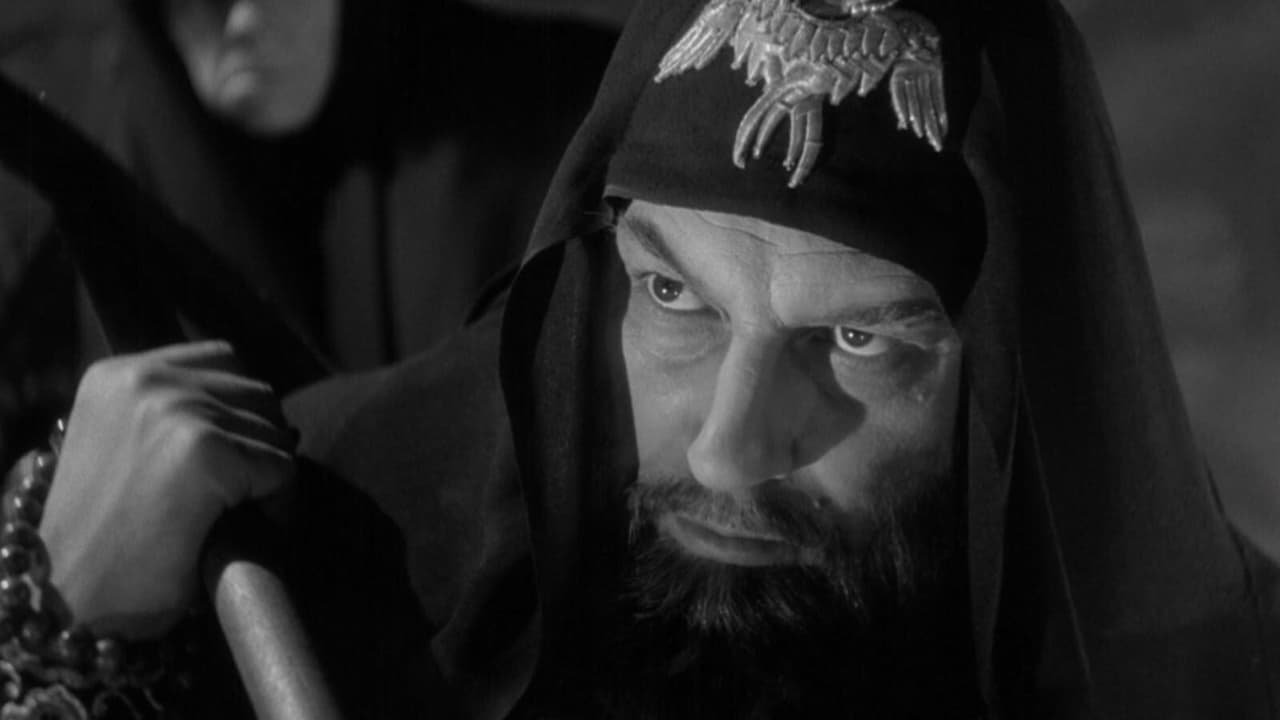treywillwest
Both of Eisenstein's Ivan films are extremely impressive, though it is part two that makes them a water-shed moment in film, and to a degree twentieth century, history.Aesthetically, perhaps the most impressive thing about the films is the art direction. That sounds like a strange thing to say about a film as intricately constructed as this one but I'll stick by it. The set pieces are not just impressive, but constitute brilliant and unique works of art in and of themselves. The nightmarishly icon-covered walls of the sets, the gorgeous but sinister props representing stupendous luxury and power, but also id-infused terror, could fill the halls of a major museum and wow in their own right, even if they were not part of a watershed-film.This is the only one of Eisenstein's films, that I know of, to be composed almost entirely of interior scenes. This gives a very claustrophobic quality, and makes the "leader of the people" seem utterly cut-off from the land and people he represents. The incredible chiaroscuro lighting also leads me to believe that Eisenstein had managed to watch the then only 7 or 8 year old Citizen Kane. Eisenstein's famed close-ups are juxtaposed with Wellsian deep focus and disorienting angles including those of ceilinged sets.And yes, that sense of detachment is what becomes, much more pointedly in part 2, the work's famed political commentary. Eisenstein had surely been prepared to die when Stalin saw the second film. It's depiction of the leader is unmistakable and, indeed, was not mistaken. Stalin repressed the second film and the planned third installment was never begun. Ivan is depicted as not so much monstrous, but trapped by power. By the second film he is more pathetic than terrifying. A man who is left desperately lonely because he has murdered all of his friends.
adeyinw
In the film Ivan the Terrible Part II, directed by Sergei Eisenstein and M. Filimonova, the main character, Nikolai Cherkasov, allows the piece to be dramatic with betrayal and no success with uniting a people. By having Cherkasov play Ivan, he is allowing himself to bring a little of Sergei Eisenstein's, whose is the writer, life into the film as well. This film that was made in 1959, allowed Eisenstein to use Ivan as a way to tell his good and bad that he has experienced while growing up. In Russia, Ivan was named Tsar, and soon after events were not going smoothly for him as planned. He wanted to unite Russia, but other people had different plans or did not think it could be done. As Ivan grew old with age, his power grew and greed as well. Also, people betraying him grew. His determination for unity and his greed in doing so led to others' actions against him. This caused him to lose his wife and his best friend. In Part II, we are given a better understanding of Ivan's pain and why he does or thinks certain things. His mother was killed just saying a few words to him before the boyars took him away. "Don't trust the boyars." Ivan lived with this for the rest of his life. Ivan's strong determination to unite Russia led to him being THE TERRIBLE as everyone called him. But during the request to come to the church, he declared himself Ivan the Terrible just like everyone else did. That is when people began to worry and the ultimate betrayal came into place, because of fear of Ivan. His own aunt that had betrayed him previously like everyone else in his life, requested to have him killed so that her son could be tsar. Before this thought was even processed in his aunt's brain, Ivan knew his wife was poisoned by his aunt, but did not chose to do anything until his cousin crossed the line and laughed at him in church. The use of Ivan's eyes told it all and that is why Ivan's aunt had to have him killed. Speaking of the eyes. Many eyes on the walls are used to give us the idea that you are always being watched. Not only are they always there, but at times in the same room but at different times, the eyes will change depending on the mood of the people in the room. For example, if there is sadness amongst a main character at the movement, then the eyes on the wall will show sadness. Also, the eyes of the people are used to communicate or express themselves as well. For example, in the opening scene of Part II, the ladies used their eyes at the palace of Poland to show interest either in Ivan's old friend or just to what he was saying. In the book, Ivan the Terrible, it says the following: Eyes in Ivan seem to have a life of their own. They move almost independently of their owners. Up and down, from side to side, slowly and swiftly, eyes draw lines inside the sockets, around the spaces their bodies inhabit, and to the depths beyond" (108). The use of the eyes in this film is what interested me. I have always been fascinated with the use of the body to explain or express something without saying a word. When I worked at an airport in Chicago, sometimes I came across people that did not speak English, so I had to use gestures to communicate with them. When I succeeded they felt helpful and I felt like I was on top of the word. So the non-verbal communication with the characters is what really stuck out for me.
atrolleynatrain
part two is undoubtedly the best half. not just for the entrancing colour scenes that flash before our eyes as a most generous gift, but also because the eerier ivan never gives in to the monster he seems to have become. ivan is depicted like a forgiving evil spirit and these opposite natures make the character the puzzling critique to despots and other scum of the sort it is. one of the works of art that has haunted me since i was a teenager and hasn't lost its spell. furthermore, the invocation of the tsar's childhood offers one of the best acting performances of both movies (part 1 and 2): ivan, the young orphan. in a way, we're eventually disarmed through the strange beauty of the boy, already the tsar, already the god-like figure. the love and care deprived angel grows into the grey bearded nocturnal predator with his thugs in black hoods only to concede damnation to his aunt, conceding her a bit of well-deserved distorted muliebrity in the lush portrait of the demented pietá. but both young and adult ivans are truly and deeply the depiction of righteousness, no matter what kingdom, no matter what purposes, and revenge itself takes the frame of sacrificial salvation with the Shakespearian counter-plot against his foes. to sum up, cherkassov's strabismus and thick eyelashes are just superficial baits to a huge masterpiece of film-making.
flasuss
SPOILERS hereinSecond and last part of Eisenstein's unfinished trilogy about the title character, it's surprisingly very different than any other of his films, including part one: if he was known for film the Russian myths and made them look even greater to the benefit of the communist regime, here the leading character is extremely humanized and it's far away from the noble hero of the previous films: betrayed by their friends, the woman he loved dead, and hated by those around him, Ivan gradually goes insane by the loneliness of the absolute power, and is so sad and obsessed to have company that he even begs on his knees to a corrupt bishop to have his friendship. The czar, like Alexander Nevsky, is clearly a representation of Stalin, and that humanization and the remind of the assassination of former allies certainly did not pleased the man which murdered more than any other in the history of the world, and the movie was censored until 1958, five years after the dictator death and ten years after the filmmaker passed away. In the end, Ivan the Terrible part II remained as one of, if not the best picture of the director, and one of the greatest achievements in the history of cinema; the genius defeated the genocidal.


 AD
AD




